
Healthy Ageing
Skin care
peer-reviewed
How to improve skin well-being by taking inspiration from centenarians’ longevity secrets
MARIE-PHILIPPINE DE LOTH1, CECILE GAVORY2
1 Marketing Manager, SEQENS Personal Care, Porcheville, France
2 R&D Manager, SEQENS Personal Care, Porcheville, France
ABSTRACT:People are living longer, want to stay healthy and enjoy life as they age. The appearance of the skin contributes greatly to the perception of a person’s age. The study of centenarians living in “Blue Zones” with above-average life expectancy, as the island of Okinawa, Japan, provides valuable insights for understanding healthy ageing. SEQENS Personal Care travelled to Okinawa to take a closer look at the nutritional and psychosocial factors behind this unique longevity and to see if parallels could be drawn at skin level. The getto plant (Alpinia speciosa) was identified: studies performed at different scales on a getto leaf extract showed beneficial cutaneous effects by promoting tissue and cellular connections, while giving the skin a healthy appearance.
??????????????????
“
“A study in healthy women providing probiotic yogurt for four weeks showed an improvement in emotional responses as measured by brain scans”

Figure 1. Skin Section with Microbiome. Most microorganisms live in the superficial layers of the stratum corneum and in the upper parts of the hair follicles. Some reside in the deeper areas of the hair follicles and are beyond the reach of ordinary disinfection procedures. There bacteria are a reservoir for recolonization after the surface bacteria are removed.
Materials and methods
Studies of major depressive disorder have been correlated with reduced Lactobacillus and Bifidobacteria and symptom severity has been correlated to changes in Firmicutes, Actinobacteria, and Bacteriodes. Gut microbiota that contain more butyrate producers have been correlated with improved quality of life (1).
A study in healthy women providing probiotic yogurt for four weeks showed an improvement in emotional responses as measured by brain scans (2). A subsequent study by Mohammadi et al. (3) investigated the impacts of probiotic yogurt and probiotic capsules over 6 weeks and found a significant improvement in depression-anxiety-stress scores in subjects taking the specific strains of probiotics contained in the yogurt or capsules. Other studies with probiotics have indicated improvements in depression scores, anxiety, postpartum depression and mood rating in an elderly population (4-7).
Other studies have indicated a benefit of probiotic supplementation in alleviating symptoms of stress. In particular, researchers have looked at stress in students as they prepared for exams, while also evaluating other health indicators such as flu and cold symptoms (1). In healthy people, there is an indication that probiotic supplementation may help to maintain memory function under conditions of acute stress.
Introduction
WHO’s Decade of Healthy Ageing
It’s no secret that the world’s population is currently living longer. People want to remain as healthy as possible later in life and enjoy well-being as they age.
In response to an ageing population, the World Health Organization (WHO) is leading The United Nations Decade of Healthy Ageing (2021-2030), a program aimed to change how we think, feel and act towards ageing among others (1). The WHO qualifies healthy ageing as “a continuous process of optimizing opportunities to maintain and improve physical and mental health, independence and quality of life throughout the life course” (2).
Longevity and the beauty industry
The demographic phenomenon of an ageing population has affected many areas of our daily lives, most notably fashion, design, food, beauty and personal care. As a direct consequence, the beauty industry has to find new solutions to adapt to the ageing of the world’s population. Therefore, the beauty landscape has evolved significantly to cater to the diversity and age range that exist today, with the emergence of pro-ageing, mid-life skincare brands, menopause beauty and the changing narrative around age. All of these trends are part of a larger movement called “longevity”, where brands and ingredient suppliers are keen to offer well-ageing solutions to their target population.
The quest for healthy ageing is also closely linked to well-being and a more holistic approach to beauty, where values from different cultures and traditions all around the world are being explored by the beauty industry and are a new source of inspiration for cosmetic ingredient suppliers. In addition, the increasing scientific understanding of the biological ageing process, the funding of ageing and longevity science have created new opportunities for suppliers and brands to offer products that address ageing and longevity at their core.
A look at a specific Blue Zone: the island of Okinawa
One of the approaches used to study longevity is to look at specific areas around the world inhabited by exceptionally long-lived populations: the Blue Zones, which are located in Sardinia (Italy), Ikaria (Greece), Okinawa (Japan), Nicoya (Costa Rica) and Loma Linda (United States) (3). Studying Blue Zones can help us understand healthy ageing and find factors associated with this highest prevalence of centenarians. One Blue Zone that caught the attention of SEQENS Personal Care was the island of Okinawa in Japan. Okinawa Island has 4 to 5 times more centenarians than Western populations (around 50 per 100,000 inhabitants) (4). Genetics, lifestyle habits, sleep health, mental well-being and nutritional factors are predictors of longevity in Okinawa. After studying the Traditional Okinawa Diet, often cited as one of the factors contributing to the healthy longevity of the Okinawa population, a plant known in Japan as getto (Alpinia speciosa, syn. Alpinia zerumbet) stood out (5).
The getto plant (Alpinia speciosa, syn. Alpinia zerumbet) as a potential skin longevity enhancer
A parallel was drawn between the getto plant’s systemic longevity effects (6) and its possible cutaneous effects on mature skin. The skin appearance contributes greatly to the person’s perception of age and well-being. By studying the botanical pharmacognosy and ethnobotany, certain discoveries put the spotlight on getto as a potential contributor of skin longevity. It promotes healthy skin ageing by improving cutaneous connections and modulating pathways involving extracellular matrix elements synthesis leading to radiant, smoothed, elastic and an overall “healthier” skin look.
A multi-scale approach has been set up to assess the getto’s plant potential on the visible improvement of skin health by promoting compartmental and cell-matrix connections at skin level. Therefore, tests were carried out at transcriptomic, proteomic and clinical scales. Thus, the ability of an Alpinia speciosa leaf extract to promote anchoring to skin cells was assessed ex vivo with treated explants versus untreated controls: the morphology and expression of key biomarkers were studied. In addition, a study on female volunteers, with wrinkles at crow’s feet, was carried out; the improvement in skin texture and complexion was assessed at 28 and 56 days.
Materials and Methods
Functionality of dermo-epidermal junction – DEJ: test ex-vivo
The active ingredient Celebr’age™ Getto (AQUA, PROPANEDIOL, ALPINIA SPECIOSA LEAF EXTRACT), property of SEQENS Personal Care, was evaluated on its capacity to boost the expression of collagen-I and laminin-5 in the dermo-epidermal junction (DEJ). Skin explants from abdominoplasty coming from a 44-year-old Caucasian woman were prepared in a culture medium at 37°C in a humid, 5% CO2 atmosphere. Celebr’age™ Getto at 2% was prepared in an aqueous gel and applied topically on day 0 (D0), D2, D3, D6 and D8 on the concerned explants; the control explants did not receive any treatment.
Explants, previously frozen at -80°C (either at D0 or D10), were cut into sections using a cryostat. Microscopical observations were carried out after laminin-5 (monoclonal anti-laminin-5 antibody) and collagen-I (polyclonal anti-collagen-I antibody) were immunostained by an automated slide processing system onto different sections. Stained surface percentage was determined by image analysis, according to the measurement of the surface of the epidermis and the measurement of the surface of the staining in the epidermis and compared for each treatment with untreated explants.
Skin appearance assessment with topical treatment: clinical study
To evaluate the efficacy of Celebr’age™ Getto on skin appearance, a clinical test was performed. A group of 25 Caucasian women, aged between 40 and 60, with wrinkles at crow’s feet, living an urban lifestyle and exposed to blue light on a daily basis were selected. This study lasted 56 days and the volunteers were asked to apply the products twice a day, i.e. the placebo cream and the cream containing Celebr’age™ Getto at2%, on each half face.
Several measurements were recorded on the volunteers on their first visit at D0, at D28 and on the last day of the study at D56. Those measurements were:
- Skin elasticity by Cutometer® MPA 580 by Courage & Khazaka
- Skin texture analysis by VISIA-CR
- Colour homogeneity by chromameter (Spectrocolorimeter CM2600D TM MINOLTA, France):
- Rosy aspect (a*) according to the international CIELab standard
- Yellowish aspect (b*) according to the international CIELab standard
The basic statistical parameters, mean and standard deviation, were calculated for each data point and recorded. Then, the assessment of the overall effect of the test product was made by calculating the variation of percentage compared to the initial measurement. In order to determine whether the identified changes were significant, a Student’s t-test was performed.
Results & Discussion
Functionality of dermo-epidermal junction – DEJ: test ex-vivo
The skin basement membrane contains unique structures that maintain attachment to the epidermis at the DEJ. Components of the attachment complex provide links to the network of basal keratinocytes and to the extracellular matrix of the papillary dermis. This interaction is necessary in maintaining the adhesive function of the basement membrane. This membrane plays important role in maintaining a healthy epidermis and dermis. The impairment of the basement membrane structure is associated with functional changes in epidermal and dermal cells and consequently facilitates the ageing process by damaging dermal extracellular matrices and inducing keratinocyte abnormality (7).
One of the key components of the anchoring complex in the basement membrane is laminin-5. Although epidermal basement membrane becomes stiffer and thicker during ageing, the expression of multiple constituents of the basement membrane structural ECM decreases, including laminin-5 (8). This implies that if the basement membrane is impaired in elderly skin, its restoration will be slower in ageing individuals, thus promoting the ageing process.
At D0, on the control explant, the staining of laminin-5 was moderate along the DEJ (Figure 1a). At D10, on the control explant, the expression of laminin-5 was moderate to quite clear along the DEJ (Figure 1b). Compared to the control explant, the other explant treated with Alpinia speciosa leaf extract 2% showed a slight increase along the DEJ (Figure 1c).
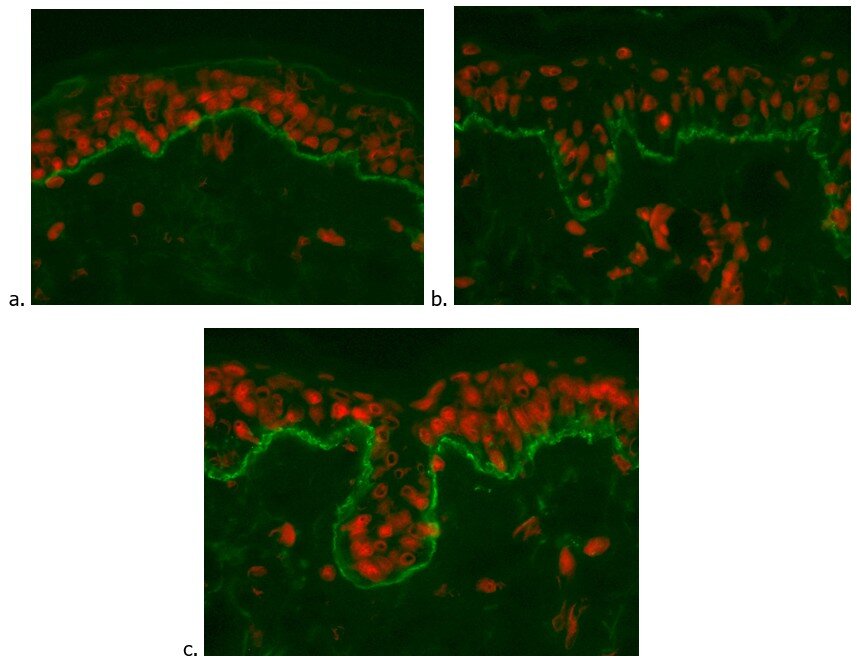
Figure 1.Laminin-5 Immunostaining: in situ visualization of laminin-5 levels by fluorescence microscopy
(laminin-5 in green, nuclei in red). a. Control explant at D0. b. Control explant at D10. c. Explant treated with Alpinia speciosa leaf extract at 2% at D10.
At D0, on the control explant, the percentage of surface positive to laminin-5 was about 50% along the DEJ (Figure 2). At D10, on the control explant, the percentage of surface positive to laminin-5 was about 44% along the DEJ (Figure 2). Compared to the control, the explant treated with Alpinia speciosa leaf extract 2% showed a significant increase of 39%. This shows a potential boosting effect on laminin-5 expression from Alpinia speciosa leaf extract at 2%.

Figure 2. Graphical representation of the quantification at D0 and D10 of Laminin-5 levels on control (blue) and Alpinia speciosa leaf extract 2% (green) treated conditions (**: p-value < 0.01).
Type I collagen is by far the most abundant protein in human skin, accounting for over 90% of its dry weight. The unique physical properties of collagen fibres provide the skin with structural integrity, in particular the mechanical tension of the skin (elasticity). Type I collagen is naturally broken down by enzymatic degradation, but this degradation is extremely slow in human skin. The human skin expresses natural inhibitors of the enzymes that degrade type I collagen, so it is very stable, taking an average of about 30 years to be replaced. However, as the skin ages and is chronically exposed to the sun, the collagen I content decreases, while an increase in the production of degrading enzymes is observed. This leads to a reduction in the mechanical tension of the skin and accentuates the appearance of aged skin (elasticity and texture) (9).
At D0, on the control explant, the staining of collagen-I was quite clear in the papillary dermis (Figure 3a). At D10, on the control explant, the expression of collagen-I had significantly decreased in the papillary dermis (Figure 3b). Compared to the control, the explant treated with Alpinia speciosa leaf extract 2% showed a slight increase in collagen-I expression in the papillary dermis (Figure 3c).
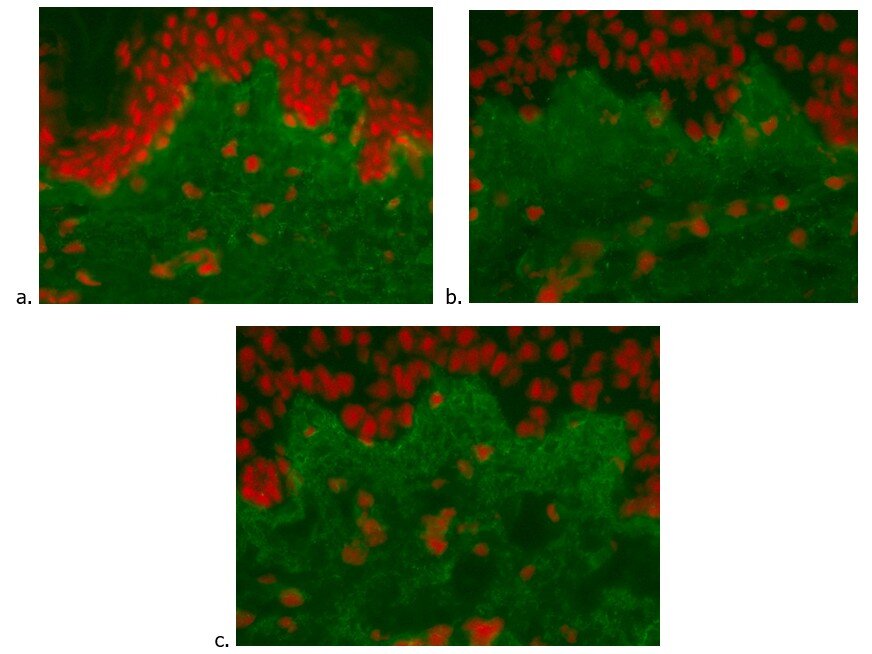
Figure 3. Collagen-I Immunostaining: in situ visualization of collagen-I levels by fluorescence microscopy (collagen-I in green, nuclei in red). a. Control explant at D0. b. Control explant at D10. c. Explant treated with Alpinia speciosa leaf extract at 2% at D10.
At D0, on the control explant, the percentage of surface positive to collagen-I was about 48% in the papillary dermis along the DEJ (Figure 4). At D10, on the control explant, the percentage of surface positive to collagen-I was about 25% in the papillary dermis along the DEJ (Figure 4). Compared to the control, the explant treated with Alpinia speciosa leaf extract 2% showed an increase of 53% and tended towards the initial level. Finally, Alpinia speciosa leaf extract at 2% may help to limit the reduction of the positive surface area to collagen-I and therefore potentially limit collagen-I degradation.
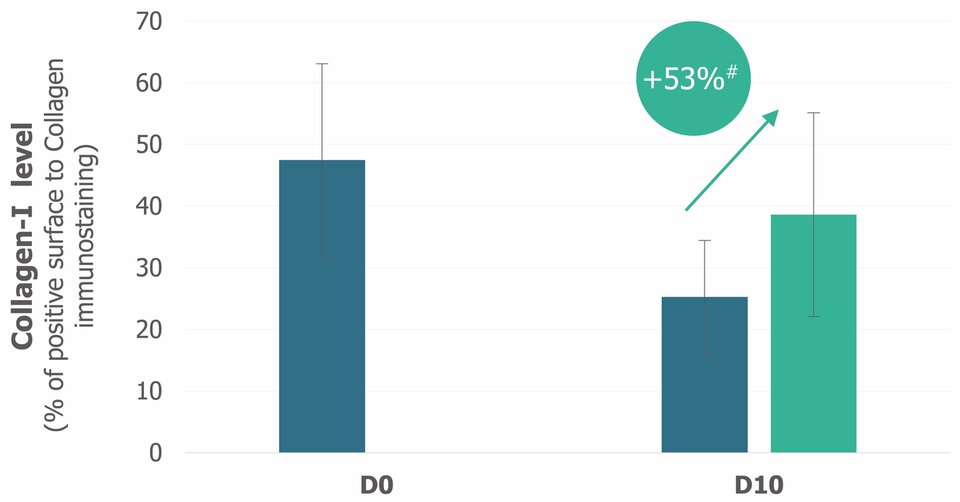
Figure 4. Quantification of Collagen-I levels at D0 and D10 on control (blue) and Alpinia speciosa leaf extract 2% (green) treated conditions (#: p-value < 0.1).
Skin appearance assessment with topical treatment: clinical study
The appearance of ones' skin reflects general health, and communicates ethnicity, lifestyle, and age. These features are largely determined by skin colour, texture, firmness, and smoothness. Ageing has a large impact on the quality of all of these features. As one ages, skin tends to become uneven in colour, roughened, lax, and wrinkled (10).
Skin elasticity
Figure 5 shows the comparative evolution of skin elasticity from D0 to D28 and from D0 to D56 with the use of the placebo cream and the cream containing Alpinia speciosa leaf extract 2%.
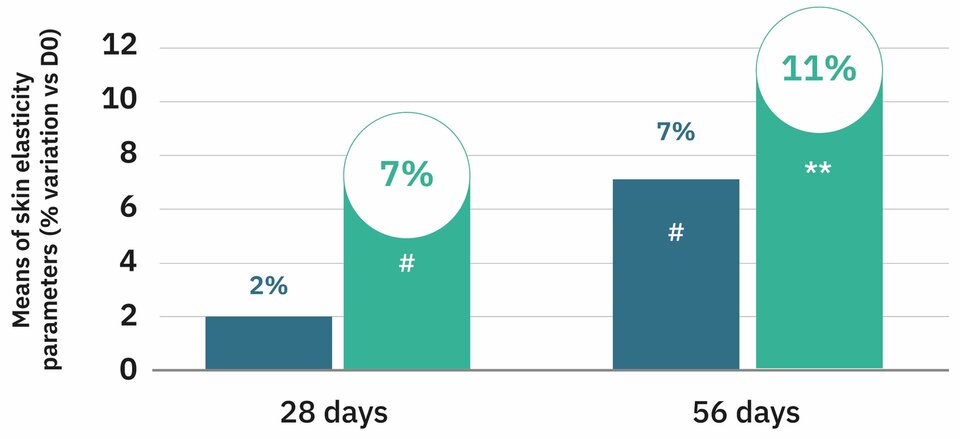
Figure 5. Evolution of the skin elasticity parameter from D0 to D28 and D0 to D56 with placebo cream (blue) and Alpinia speciosa leaf extract 2% cream (green) (#: p-value < 0.1 statistically significant versus D0, **: p-value < 0.01 statistically significant versus D0).
The placebo did not significantly improve skin elasticity after 28 days of use. Alpinia speciosa leaf extract 2% significantly improved the elasticity after 28 and 56 days of use with higher significance than with placebo, up to an average of 11% after 56 days of use (p < 0.01).
Skin texture: topography analysis
Figure 6 presents the evolution of skin texture (skin reliefs) from D0 to D28 and from D0 to D56 with the use of placebo or Alpinia speciosa leaf extract 2%.

Figure 6. Evolution of the skin texture parameter from D0 to D28 and D0 to D56 with placebo cream (blue) and Alpinia speciosa leaf extract 2% cream (green) (*: p-value < 0.05 statistically significant versus D0, °: p-value < 0.1 statistically significant versus placebo)
The placebo did not significantly reduced skin relief after 28 and 56 days of use. Alpinia speciosa leaf extract 2% improved the skin texture, by smoothing raised and depressed areas of the skin -and thus diminishing the texture of the skin-, after 28 and 56 days of use, with a significant effect after 56 days (-12%, p < 0.05).
Colour homogeneity
Figure 7 presents the evolution of skin rosiness and its yellowish aspect from D0 to D28 and from D0 to D56 with the use of placebo or Alpinia speciosa leaf extract 2%.

Figure 7. Evolution of the skin rosy (a*) and yellowish appearance (b*) parameters from D0 to D28 and D0 to D56 with placebo cream (blue) and Alpinia speciosa leaf extract 2% cream (green) (*: p-value < 0.05 statistically significant versus D0, **: p-value < 0.01 statistically significant versus D0, ***: p-value < 0.001 statistically significant versus D0, °: p-value < 0.1 statistically significant versus placebo).
The placebo did not improve the skin rosy aspect (a*) after 28 and 56 days of use. Alpinia speciosa leaf extract 2% improved the skin rosy aspect after 28 and 56 days of use. Also, a significant difference of a* was observed between Alpinia speciosa leaf extract 2% and the placebo after 28 days of use (-1% vs. 5%* with p < 0.05 for the active).
Alpinia speciosa leaf extract 2% significantly decreased the skin yellowish aspect (b*) after 28 and 56 days of use with a higher significance than with the placebo (p < 0.001).
In conclusion, Alpinia speciosa leaf extract 2% promotes the rosy aspect of the skin while reducing the yellowish aspect.
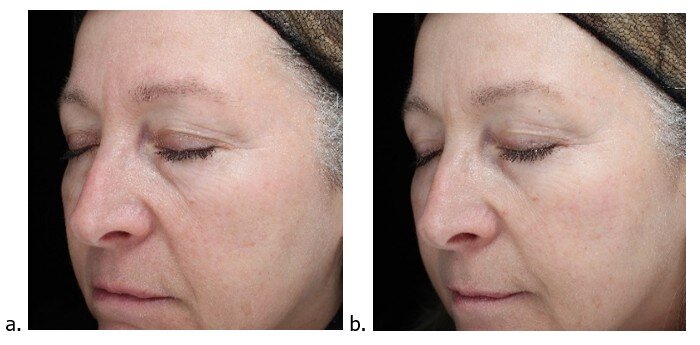
Figure 8. Photographs of a representative volunteer at a. D0 and b. D28.
After 28 days of Alpinia speciosa leaf extract 2% application, skin radiance and smoothness are visibly enhanced, with an overall global skin improvement. The skin has a healthier aspect thanks to an increase in rosy versus yellowish tones (Figure 8a and 8b).
Conclusion
In response to a new way of approaching ageing and how people are embracing it, the longevity trend is rising in the beauty industry. Following this trend, inspiration from the Blue Zones, their centenarians and their traditions, has helped suppliers to provide the cosmetic market with holistic and pro-ageing natural ingredients, such as SEQENS Personal Care’s getto leaf extract.
The studies show that the getto (Alpinia speciosa) extract, in addition to its nutritional effect, also had a beneficial cutaneous effect with topical application by promoting tissue and skin cells anchorage, while giving the skin a healthy appearance. Indeed, the ingredient examined in the study enhances skin radiance and smoothness, boosts the extracellular matrix synthesis and assembly, increases skin structure reconnections and enhances dermo-epidermal structures. The getto (Alpinia speciosa) leaf extract thus represents a botanical active cosmetic ingredient which falls within the scope of the “longevity” skincare product segment. Hence, these products no longer try, in vain, to make time stand still, but rather embrace the passing of time by promoting healthy ageing.
Conclusion
The future of cosmetics lies in the continued evolution of holistic approaches which represents a transformative shift in the industry, merging scientific advancements, natural ingredients, and wellness principles. By understanding and embracing the interconnectedness of these elements, the cosmetics industry can cultivate products that not only enhance external beauty but also contribute to the overall well-being of individuals and the planet.
The interplay between beauty from within and topical cosmetics is the key for future products. The integration of biotechnology and green chemistry is revolutionizing cosmetic formulations, offering sustainable and biocompatible alternatives.
Developers can implement blockchain to trace the journey of ingredients from source to product. Nevertheless, the efficacy of the natural products should be scientifically proven. Marketers can communicate transparency as a brand value, and parallelly educate consumers by highlighting how specific ingredients contribute to radiant and healthy skin.
By embracing the synergy between these approaches and leveraging scientific advancements, the cosmetics industry can provide consumers with comprehensive beauty solutions that cater to both internal and external dimensions of beauty.
Surfactant Applications

The application area lends itself particularly well to the use of AI. Active today in this area is the US company Potion AI (6). The company provides AI-powered formulation tools for beauty and personal care R&D. Their offerings include Potion GPT, next generation ingredient and formula databases and AI document processing. Potion’s work could have a significant impact on the entire surfactant value chain, from raw material suppliers to end consumers. By using their GPT technology, they can help target work toward novel surfactant molecules that have optimal properties for specific applications. By using their ingredient and formula databases, they can access and analyze a vast amount of data on surfactant performance, safety, and sustainability. By using their AI document processing, they can extract and organize relevant information from patents, scientific papers, and regulatory documents. These capabilities could enable Potion AI's customers to design and optimize surfactant formulations that are more effective, eco-friendly, and cost-efficient. A particularly interesting application for this type of capability is deformulation.
Deformulation is the process of reverse engineering a product's formulation by identifying and quantifying its ingredients. Deformulation can be used for various purposes, such as quality control, competitive analysis, patent infringement, or product improvement. However, deformulation can be challenging, time-consuming, and costly, as it requires sophisticated analytical techniques, expert knowledge, and access to large databases of ingredients and formulas.
AI can potentially enhance and simplify the deformulation process by using data-driven methods to infer the composition and structure of a product from its properties and performance. For example, AI can use machine learning to learn the relationships between ingredients and their effects on the product's characteristics, such as color, texture, fragrance, stability, or efficacy. AI can also use natural language processing to extract and analyze information from various sources, such as labels, patents, literature, or online reviews, to identify the possible ingredients and their concentrations in a product.

Figure 2. Skin Section with Microbiome. Most microorganisms live in the superficial layers of the stratum corneum and in the upper parts of the hair follicles. Some reside in the deeper areas of the hair follicles and are beyond the reach of ordinary disinfection procedures. There bacteria are a reservoir for recolonization after the surface bacteria are removed.
References and notes
- What is the UN Decade of Healthy Ageing? – The Platform [Internet]. [cited 2025 May 26]. Available from: https://www.decadeofhealthyageing.org/about/about-us/what-is-the-decade
- Healthy Aging - PAHO/WHO | Pan American Health Organization [Internet]. 2025 [cited 2025 May 26]. Available from: https://www.paho.org/en/healthy-aging
- Poulain M, Herm A, Pes G. The Blue Zones: areas of exceptional longevity around the world. Vienna Yearb Popul Res. 2013;11:87–108.
- Willcox DC, Willcox BJ, He Q, Wang N chiang, Suzuki M. They Really Are That Old: A Validation Study of Centenarian Prevalence in Okinawa. J Gerontol Ser A. 2008 Apr 1;63(4):338–49.
- Teschke R, Xuan TD. Viewpoint: A Contributory Role of Shell Ginger (Alpinia zerumbet) for Human Longevity in Okinawa, Japan? Nutrients. 2018 Feb;10(2):166.
- Chompoo J, Upadhyay A, Fukuta M, Tawata S. Effect of Alpinia zerumbet components on antioxidant and skin diseases-related enzymes. BMC Complement Altern Med. 2012 Jul 24;12(1):106.
- Amano S. Possible Involvement of Basement Membrane Damage in Skin Photoaging. J Investig Dermatol Symp Proc. 2009 Aug 1;14(1):2–7.
- Rittié L, Farr EA, Orringer JS, Voorhees JJ, Fisher GJ. Reduced cell cohesiveness of outgrowths from eccrine sweat glands delays wound closure in elderly skin. Aging Cell. 2016;15(5):842–52.
- Fisher GJ, Varani J, Voorhees JJ. Looking Older: Fibroblast Collapse and Therapeutic Implications. Arch Dermatol. 2008 May 1;144(5):666–72.
- Krutmann J, Bouloc A, Sore G, Bernard BA, Passeron T. The skin aging exposome. J Dermatol Sci. 2017 Mar 1;85(3):152–61.

